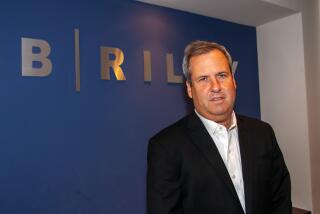Great American Reports Profit of $20.1 Million
- Share via
Thanks to a non-recurring $77.7-million gain on the sale of investment securities, Great American First Savings Bank reported a $20.1-million profit for the fourth quarter ended Dec. 31, up from its $13.1-million profit for the same quarter in 1987.
The gain, made on the sale of Great American’s remaining Federal Home Loan Mortgage Corp. (Freddie Mac) shares, helped counterbalance a $72-million provision for probable loan and interest losses, a charge on earnings.
Great American also sold the balance of its Freddie Mac stock in the third quarter and the gain of $17.5 million enabled the S&L; to show a profit then as well.
The large loan-loss provision is part of Great American’s continuing effort to bring its problem loans under control. The provision reduces the S&L;’s non-performing loans to $382 million as of Dec. 31, or 2.4% of $16.1 billion in assets. That’s a considerable improvement from March, 1988, when bad loans totaled $556 million, or nearly 3.7% of assets.
Jim Krzeminski, chief financial officer, said Great American hopes to reduce its bad loans to 2% of assets by the end of 1989. The S&L; has attributed much of its loan problems to the overbuilt Phoenix real estate market. Great American inherited a significant loan portfolio there in 1986 when it acquired Great American/Arizona.
For the full year, Great American reported a profit of $50.3 million, down from $88.1 million in fiscal 1987. The lower fiscal-year profit came despite gains totaling $96 million on investment transactions, including the sale of Freddie Mac stock, contrasted with gains of $59 million in fiscal 1987.
Although analysts generally praised Great American’s reduced bad-loan portfolio as well as its timing of the Freddie Mac stock sale, several expressed reservations about Great American’s “core earnings,” or money made from its lending activities. Those earnings are now being dragged down, they said, by Great American’s sale in recent years of high-quality packaged loans to boost earnings.
Great American’s interest-rate “spread,” or the difference between its cost of funds and money earned from lending activity figured as a percentage of assets, was 1.97% for all of 1988. That’s significantly below the 2.55% interest spread at H. F. Ahmanson, parent company of Home Savings, the 2.7% spread at Home Federal Savings and the “close to 2.85%” spread at Great Western Savings, said Gary Gordon, a securities analyst with Paine Webber in New York.
“Their core earnings didn’t deteriorate, but they did not improve,” Gordon said. “They have a lot of loans not earning interest and, over the last few years, they have been generating lots of earnings by selling their best loans. Those aren’t around making earnings,” Gordon said.
Another Wall Street analyst who follows Great American and who asked not to be named said Great American’s low spread is worrisome because, if interest rates go up as the analyst expects in 1989, the S&L; will find it harder to compensate for a squeezed interest spread with further gains on sale of loans and securities.
Krzeminski said Great American was slower than other S&Ls; in converting its portfolio from predominantly fixed-rate loans to those with variable interest rates indexed to its cost of funds. Last year, however, 94% of all Great American’s loans carried adjustable interest rates, Krzeminski said.
Great American’s fourth-quarter earnings were also boosted by $17 million in gains from real estate investments, contrasted with a loss of $7 million in the comparable quarter the previous year.
More to Read
Inside the business of entertainment
The Wide Shot brings you news, analysis and insights on everything from streaming wars to production — and what it all means for the future.
You may occasionally receive promotional content from the Los Angeles Times.








